The Church Tower of Santiago Apóstol in Montilla: An Eco-Sustainable Rehabilitation Proposal
Abstract
:1. Introduction
2. Materials and Methods
2.1. Methods for Evaluating Rehabilitation with Eco-Sustainable Criteria
- Environmental Focus:
- -
- Energy consumed in the transport of material or components (ECTM) needed for the intervention. The fact that they must come from companies close to the place, as will be discussed below within the social focus, will have a positive impact on this indicator.
- -
- Energy consumed in the installation and application process of the materials used (ECIP).
- -
- Assessment of the degree of eco-sustainability of the material and natural resources used (ALEQ). In this case, measuring whether the resources used count as eco-sustainable or are in the process of obtaining an official quality certification in this regard.
- -
- Level of use of reusable and recycled materials (LURRM), establishing a ratio between the total quantity of materials used and the portion that is reusable and recycled. A high rate of recycled and reusable materials will help indicate an eco-sustainable rehabilitation, and support the circular economy model, which in turn supports the reduction of raw materials through the application of the 3R concept (reduce, reuse, and recycle).
- -
- Management of generated waste, measuring the level of waste generated and the treatment given. The aim is to minimize polluting waste in favor of biodegradable or reusable waste. We will make a distinction here between the level of reusable (MRW) and recycled waste (MRcW)
- Social Focus:
- -
- Ecological Footprint of Service and Resource Providers (EFSRP), as an indicator of the environmental impact of companies providing services and resources. Here, possessing an accreditation or being in the process of becoming accredited with some reputable certification will be considered [12].
- -
- Distance from providers to the intervention site (DPIS). Reduced distance will bring benefits in terms of the impact on employment and generation of wealth in the local environment. It will also have positive consequences for the level of pollution generated by transportation.
- -
- Hiring of labor from the local environment (LE). This will promote employment and generate wealth within the geographical environment where the intervention must be carried out. Especially when considering the economic crisis in which we find ourselves today as a consequence of the coronavirus pandemic, this can have direct positive effects.
- Economic Focus:In the framework of a circular economy, it is not only necessary to reduce the cost for the company in its activities, but to reduce the entry of virgin materials and the production of waste. This criterion is directly related to the ecological footprint indicator previously explained, as well as the use of renewable energy. We must analyze the resulting logistics costs, which include the managing cost, storage cost, transport cost, administrative cost, and financial cost.
3. Results
3.1. Descriptive and Historical Analysis
- Restoration of the windows, with sealing and replacement of defective or worn parts.
- Cleaning and waterproofing of the roof and its main channels for the evacuation of rainwater.
- Restoration of the cracks in the dome and the disfigured plaster of the window.
- General review of plaster.
3.2. Intervention Proposal Method Applied to the Case Study
- Cleaning the roof.
- Review of the wire mesh window coverings.
- Cleaning of the inside of the tower.
3.3. Execution of an Eco-Sustainable Rehabilitation within the Case Study
3.4. Problems Detected for Eco-Sustainable Rehabilitation in the Case Study
- Using eco-sustainable materials and resources.
- Finding local providers of eco-sustainable resources.
- Completion time.
- Management of the waste.
4. Conclusions
Author Contributions
Funding
Conflicts of Interest
References
- Decreto 111/2001, de 30 de Abril, por el que se Declara Bien de Interés Cultural, Con la Categoría de Monumento, la Iglesia de Santiago, en Montilla (Córdoba). Available online: https://www.juntadeandalucia.es/boja/2001/81/37 (accessed on 28 July 2020).
- Ley 16/1985, de 25 de Junio, del Patrimonio Histórico Español. Available online: http://noticias.juridicas.com/base_datos/Admin/l16-1985.html (accessed on 28 July 2020).
- Ley 14/2007, de Patrimonio Histórico de Andalucía. Available online: http://noticias.juridicas.com/base_datos/CCAA/an-l14-2007.html (accessed on 28 July 2020).
- Barbero-Barrera, M.M.; Fernández-Rodríguez, M.A.; Flores-Medina, N.; Pinilla-Melo, J. La materialidad de la arquitectura. In V Encuentro sobre Experiencias Innovadoras en la Docencia; Universidad Complutense de Madrid: Madrid, Spain, 2015; Available online: https://www.edificacion.upm.es/innovacion/2015/18.La%20Materialidad_BARBERO_FERNANDEZ_FLORES_PINILLA.pdf (accessed on 28 July 2020).
- García-Alvarado, R. Los límites de la materialidad. Tres cualidades arquitectónicas para el próximo siglo. In Arquitectura del Sur; Universidad del Bío-Bío: Santiago, Chile, 1998; Volume 14, p. 27. Available online: https://dialnet.unirioja.es/servlet/articulo?codigo=5231434 (accessed on 28 July 2020).
- Convención Marco de las Naciones Unidas sobre el Cambio Climático (CMNUCC). Available online: https://www.miteco.gob.es/es/cambio-climatico/temas/el-proceso-internacional-de-lucha-contra-el-cambio-climatico/naciones-unidas/CMNUCC.aspx (accessed on 28 July 2020).
- Protocolo de Kioto. Available online: http://unfccc.int/resource/docs/convkp/kpspan.pdf (accessed on 28 July 2020).
- Directiva 2010/31/EU del Parlamento Europeo y del Consejo, de 19 de Mayo de 2010, Relativa a la Eficiencia Energética de los Edificios. Available online: https://eur-lex.europa.eu/legal-content/ES/TXT/?uri=celex%3A32010L0031 (accessed on 28 July 2020).
- Bell, S.; Morse, S. Sustainability Indicators Past and Present: What next? Sustainability 2018, 10, 1688. [Google Scholar] [CrossRef] [Green Version]
- Viñolas, B.; Cortés, F.; Marques, A.; Josa, A.; Aguado, A. MIVES: Modelo Integrado de Valor para Evaluaciones de Sostenibilidad. In II Congrés Internacional de Mesura i Modelizació de la Sostenibilitat; Centro Internacional de Métodos Numéricos en Ingeniería (CIMNE): Barcelona, Spain, 2009; Available online: https://upcommons.upc.edu/handle/2117/9704?locale-attribute=es (accessed on 28 July 2020).
- Rüdisser, J.; Leitinger, G.; Schirpke, U. Application of the Ecosystem Service Concept in Social-Ecological Systems-from Theory to Practice. Sustainability 2020, 17, 2960. [Google Scholar]
- Wüest, T.; Grobe, L.O.; Luible, A. An innovative Gaçade Element with Controlled Solar-Thermal Collector and Storage. Sustainability 2020, 12, 5281. [Google Scholar]
- Quintanilla Raso, M.C. Nobleza y Señoríos en el Reino de Córdoba: La casa de Aguilar (s. XIV-XV), 1st ed.; Monte Piedad y Caja de Ahorros de Córdoba: Córdoba, Spain, 1979; Available online: https://dialnet.unirioja.es/servlet/libro?codigo=609190 (accessed on 28 July 2020).
- Ramírez de Arellano, R. Inventario-Catálogo Histórico Artístico de Córdoba, 1st ed.; Monte Piedad y Caja de Ahorros de Córdoba: Córdoba, Spain, 1982; p. 431. [Google Scholar]
- Lorenzo Muñoz, F.B. Historia de la M. N.L. Ciudad de Montilla, Montilla, Spain, Unpublished work. 1779.
- Jurado y Aguilar, A. Historia de Montilla, Montilla, Spain, Unpublished work. 1777.
- Jurado y Aguilar, L. Historia de Montilla, Montilla, Spain, Unpublished work. 1763.
- Garramiola Prieto, E. Las torres de Santiago (I). Munda-Montulia, Excmo Ayuntamiento de Montilla: Montilla, Spain, Unpublished work. 1979. [Google Scholar]
- Nieto Cumplido, M. Aproximación histórica a la historia de Montilla en los siglos XIC y XV. In Montilla, Aportaciones Para su Historia (I Ciclo de Conferencias Sobre la Historia de Montilla); Delegación de Cultura del Excmo. Ayuntamiento de Montilla: Montilla, Spain, 1982; p. 299. [Google Scholar]
- García Ortega, A.J. De Mezquitas a Iglesias. Formalización y Trazado en los Procesos de Reconversión de Toledo y Córdoba. EGA Expr. Gráfica Arquit. 2015, 26, 202–211. Available online: https://polipapers.upv.es/index.php/EGA/article/view/4053 (accessed on 28 July 2020).
- Suárez Medina, R. El Sonido del Espacio Eclesial en Córdoba. El Proyecto Arquitectónico Como Procedimiento Acústico. Ph.D. Thesis, Universidad de Sevilla, Sevilla, Spain, 2002; pp. 24–31. Available online: https://idus.us.es/handle/11441/15659 (accessed on 28 July 2020).
- Delgado López, D. Historia de Montilla. Breve Resumen General de España, Tomo I, Montilla, Spain, Unpublished work. 1895. [Google Scholar]
- Morte Molina, J. Montilla: Apuntes Históricos de Esta Ciudad; Imprenta, Papelería y Encuadernación de M. de Sola Torices: Montilla, Spain, 1888; Available online: http://www.bibliotecavirtualdeandalucia.es/catalogo/es/consulta/registro.cmd?id=1001022 (accessed on 28 July 2020).
- Baena Sánchez, A. Estudio Histórico-Técnico y Reconstrucción Virtual del Alhorí de los Duques de Medinaceli de Montilla a Través de la Obra del Arquitecto Juan Antonio Camacho de Saavedra. Ph.D. Thesis, Universidad de Córdoba, Córdoba, Spain, 2018. Available online: https://helvia.uco.es/xmlui/handle/10396/16876 (accessed on 28 July 2020).
- Martín González, J.J. Historia del Arte. Tomo II; Editorial Gredos: Madrid, Spain, 1978; pp. 38–56. [Google Scholar]
- Archivo Histórico de Protocolos Notariales de Montilla (A.H.P.N.M.), Escribanos siglo XVI, Legajo 143. Fundación Biblioteca Manuel Ruiz Luque: Montilla (Córdoba), Spain, Unpublished work. 1577.
- Navascués Palacio, P. El Libro de la Arquitectura de Hernán Ruiz, el Joven. Estudio y edición crítica, 1st ed.; Escuela Técnica Superior de Arquitectura de Madrid: Madrid, Spain, 1979; p. 16. [Google Scholar]
- Sánchez González, A. El arte en la representación del espacio. Mapas y planos de la colección Medinaceli, 1st ed.; Servicio de Publicaciones de la Universidad de Huelva: Huelva, Spain, 2017; pp. 340–341. [Google Scholar]
- Archivo Central de la Consejería de Cultura y Patrimonio Histórico de Andalucía (A.C.C.C.P.H.A.) A9.004.14. Consejería de Cultura y Patrimonio Histórico: Sevilla, Spain, 1577; Unpublished work.
- Suárez, M.; Gómez Baggethun, E.; Benayas, J.; Tilbury, D. Towards an Urban Resilience Index: A Case Study in 50 Spanish Cities. Sustainability 2016, 8, 774. [Google Scholar]
- Herráez, J.A.; Pastor, M.J.; Durán, D. Guía para la Elaboración e Implantación de Planes de Conservación Preventiva; Ministerio de Cultura y Deporte: Madrid, Spain, 2019. Available online: https://es.calameo.com/read/00007533531922e9ec8e8 (accessed on 28 July 2020).
- Go-Eum, K.; Jeon-Ran, L. The impact of Historic Building Preservation in Urban Economics: Focusing on Accommodation Prices in Jeonju Hanok Village, South Korea. Sustainability 2020, 12, 5005. [Google Scholar]
- Quintana López, T. Urbanismo Sostenible. Rehabilitación, Regeneración y Renovación Urbanas, 1st ed.; Tirant-LoBlanch: Valencia, Spain, 2016; pp. 373–381. [Google Scholar]
- Ruiz Palomeque, G. Sustainable renovation management of Large Urban Ensembles by local public administration. Inf. Constr. 2015, 67. [Google Scholar] [CrossRef]
- Mercader Moyano, P.; Roldán Porras, J. Evaluating Environmental Impact in Foundations and Structures through Disaggregated Models: Towards the Decarbonisation of the Construction Sector. Sustainability 2020, 12, 5150. [Google Scholar] [CrossRef]
- Código Técnico de Edificación Español. Available online: https://www.codigotecnico.org (accessed on 28 July 2020).
- Al Khatib, B.; Soon Poh, Y.; El-Shafie, A. Materials Challenges in Reconstruction of Historical Projects: A Case Study of the Old Riwaq Project. Sustainability 2019, 11, 4533. [Google Scholar] [CrossRef] [Green Version]
- Logic Clean. ¿Cómo es y Cómo se Hace una Limpieza Sostenible? Available online: https://www.logicclean.es/una-limpieza-ecologica-sostenible/ (accessed on 18 July 2020).
- Arquitectura sostenible. Pinturas ecológicas, 100% Sostenibles. Available online: https://arquitectura-sostenible.es/pinturas-ecologicas-100-sostenibles/ (accessed on 10 July 2020).
- Real Decreto 105/2008, de 1 de Febrero, por el que se Regula la Producción y Gestión de Residuos de Construcción y Demolición. Available online: http://www.juntadeandalucia.es/medioambiente/portal_web/web/temas_ambientales/residuos_2/marco_normativo/boe_rcd.pdf (accessed on 28 July 2020).
- Decreto 73/2012, de 22 de Marzo, por el que se Aprueba el Reglamento de Residuos de Andalucía. Available online: https://www.juntadeandalucia.es/boja/2012/81/4 (accessed on 28 July 2020).
- Agencia de Obra Pública de la Junta de Andalucía; Consejería de Fomento y Vivienda de la Junta de Andalucía. Gestión y Tratamiento de Residuos de Construcción y Demolición (RCD). Guía de buenas prácticas; Agencia de Obra Pública de la Junta de Andalucía: Córdoba, Spain; Consejería de Fomento y Vivienda de la Junta de Andalucía: Córdoba, Spain, 2015. Available online: http://www.juntadeandalucia.es/medioambiente/portal_web/servicios_generales/doc_tecnicos/2015/gestion_tratamiento_residuos_construc_demolic/gestion_tratamiento_residuos_RCD_buenas_practicas.pdf (accessed on 28 July 2020).
- Sanz Cabrera, J. Restauración de Sta. María la Mayor (SMLM). Baena. Córdoba. Spain. La austeridad y eficiencia en la recuperación de los espacios perdidos. In Libro de Actas del 3er Congreso Internacional de Construcción Sostenible y Soluciones Ecoeficientes; University of Seville: Sevilla, Spain, 2017; Available online: https://idus.us.es/bitstream/handle/11441/59609/Sanz%20cabrera%2C%20jerónimo%20%28espa%29.pdf?sequence=2&isAllowed=y (accessed on 28 July 2020).
- Corgnati, S.; Filipi, M.; Perino, M. A new approach for the IEQ assessment, research in building physics and building engineering. In Proceeding of the 3rd International Conference on Research in Building Physics IBPC 2006; Taylor & Francis Group: Montreal, QC, Canada, 2006; Available online: https://www.researchgate.net/publication/279878849_A_new_approach_for_the_IEQ_Indoor_Environment_Quality_assessment (accessed on 28 July 2020).
- Blandón, B.; Palmero, L.; di Ruocco, G. The Revaluation of Uninhabited Popular Patrimony under Environmenthal and Sustainability Parameters. Sustainability 2020, 12, 5629. [Google Scholar]
- Diulio, M.P.; Mercader-Moyano, P.; Gómez, A.F. The influence of the envelope in the preventive consevation of books and paper records. Case study: Libraries and archives in La Plata. Elsevier Energy Build. 2019, 183, 727–738. [Google Scholar] [CrossRef]
- Candelas-Gutiérrez, A. The Power of Geometrix Relationships in Mudéjar Timber Roof Frames. Nexus Netw. J. 2017, 19, 521–545. [Google Scholar] [CrossRef]
- Candelas-Gutiérrez, A.; Borrallo-Jiménez, M. Methology of Restoration of Historical Timber Roof Frames. Application to Traditional Spanish Structural Carpenty. Int. J. Archit. Herit. 2020, 14, 51–74. [Google Scholar] [CrossRef]
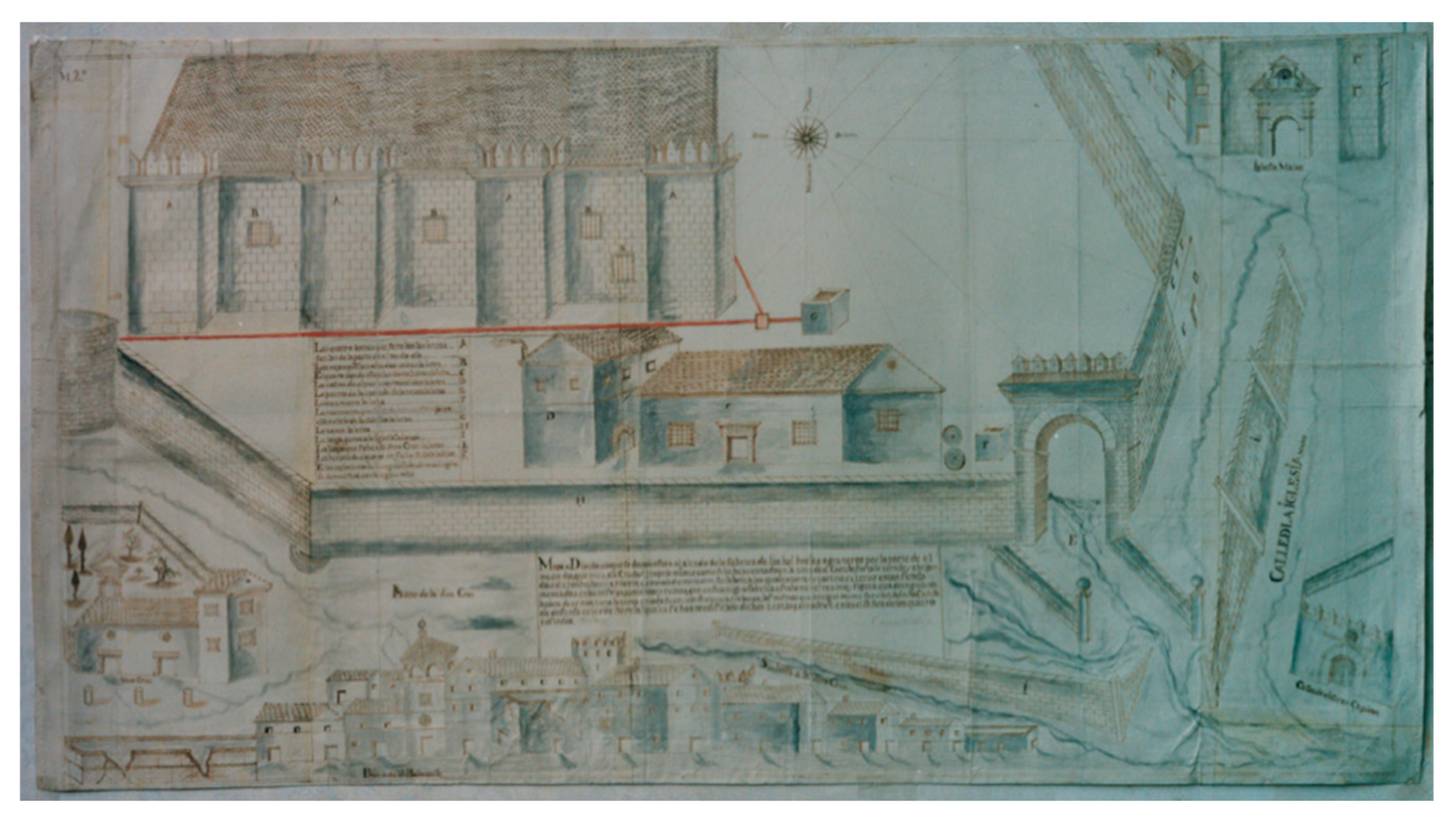

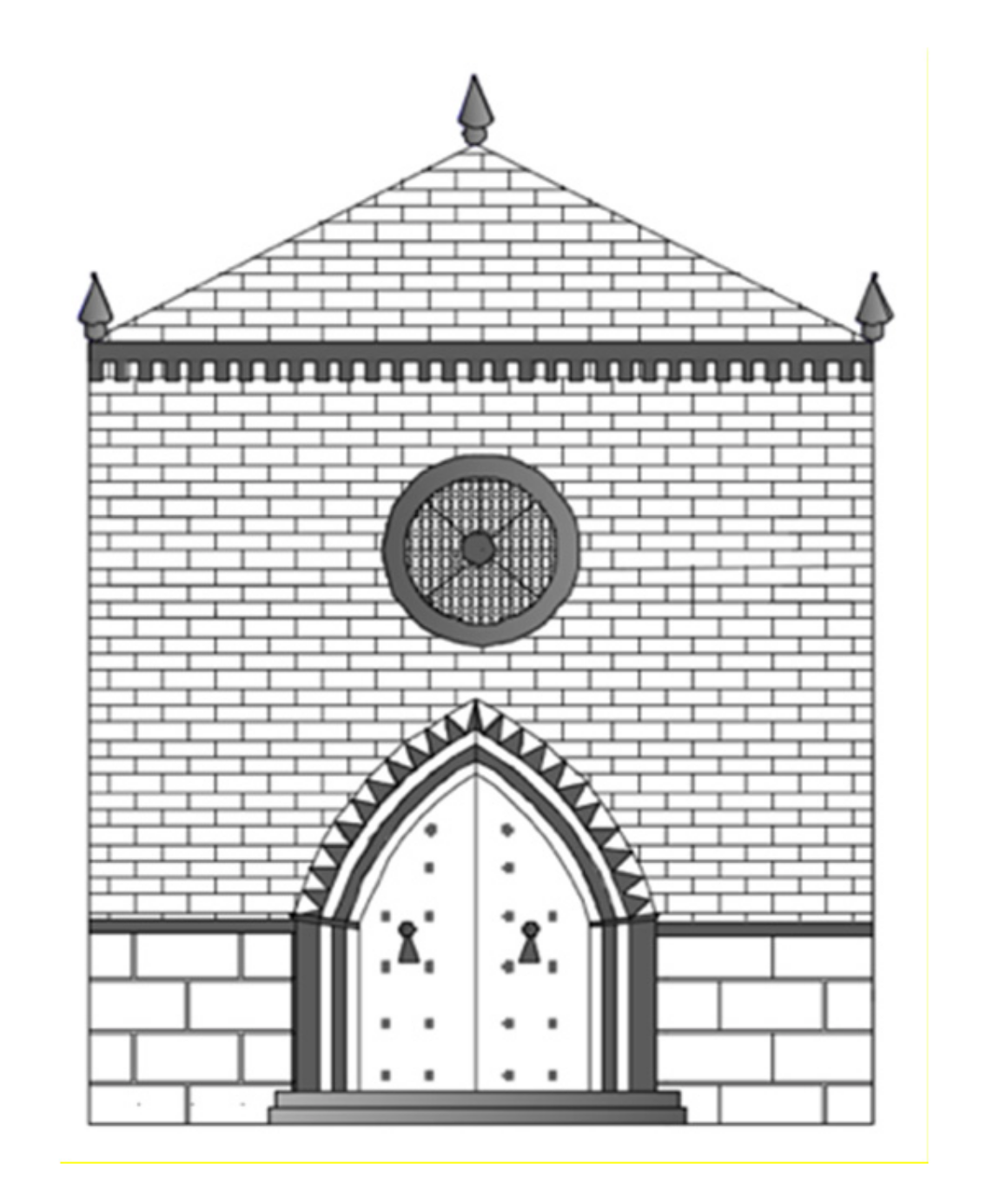
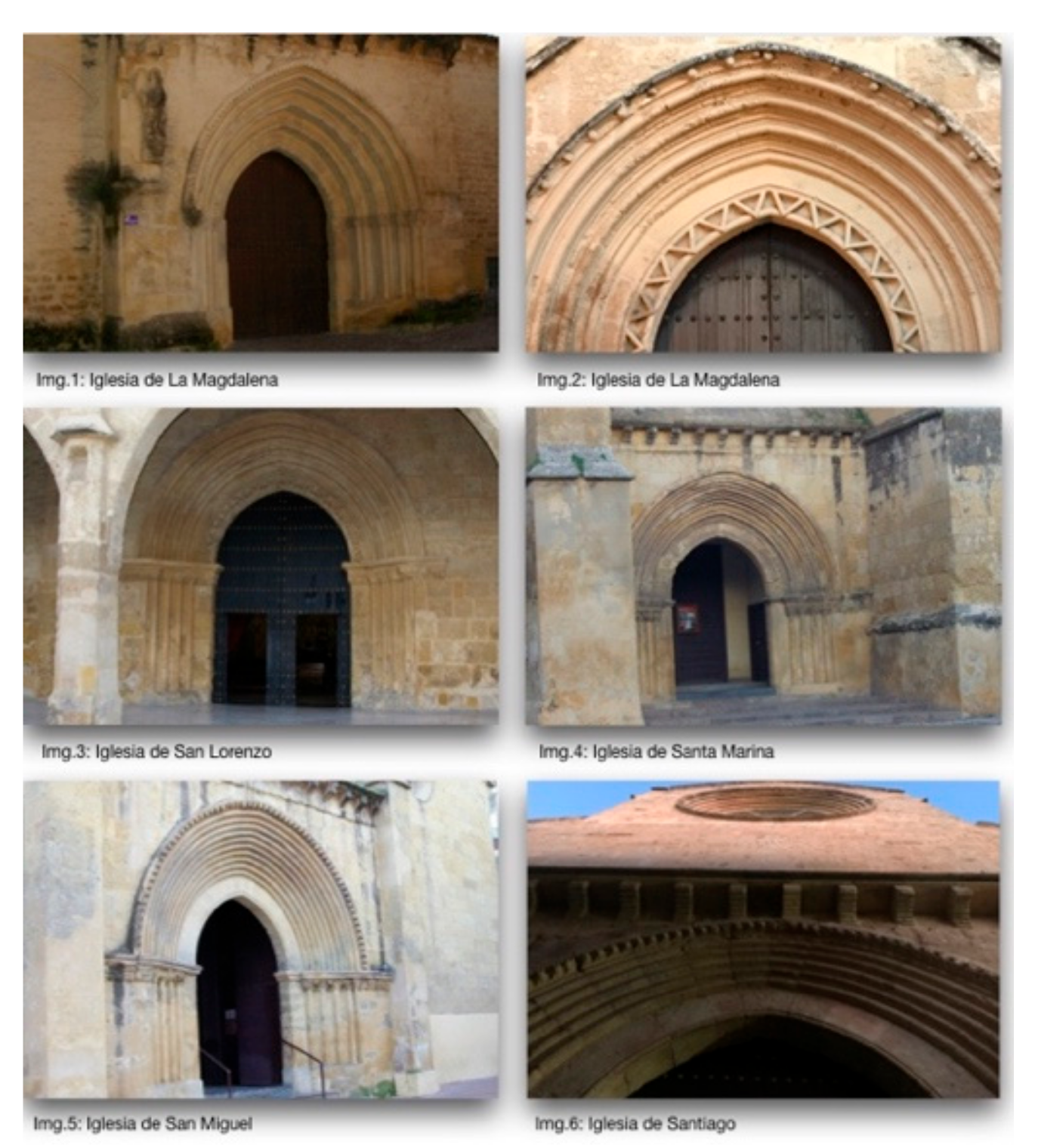
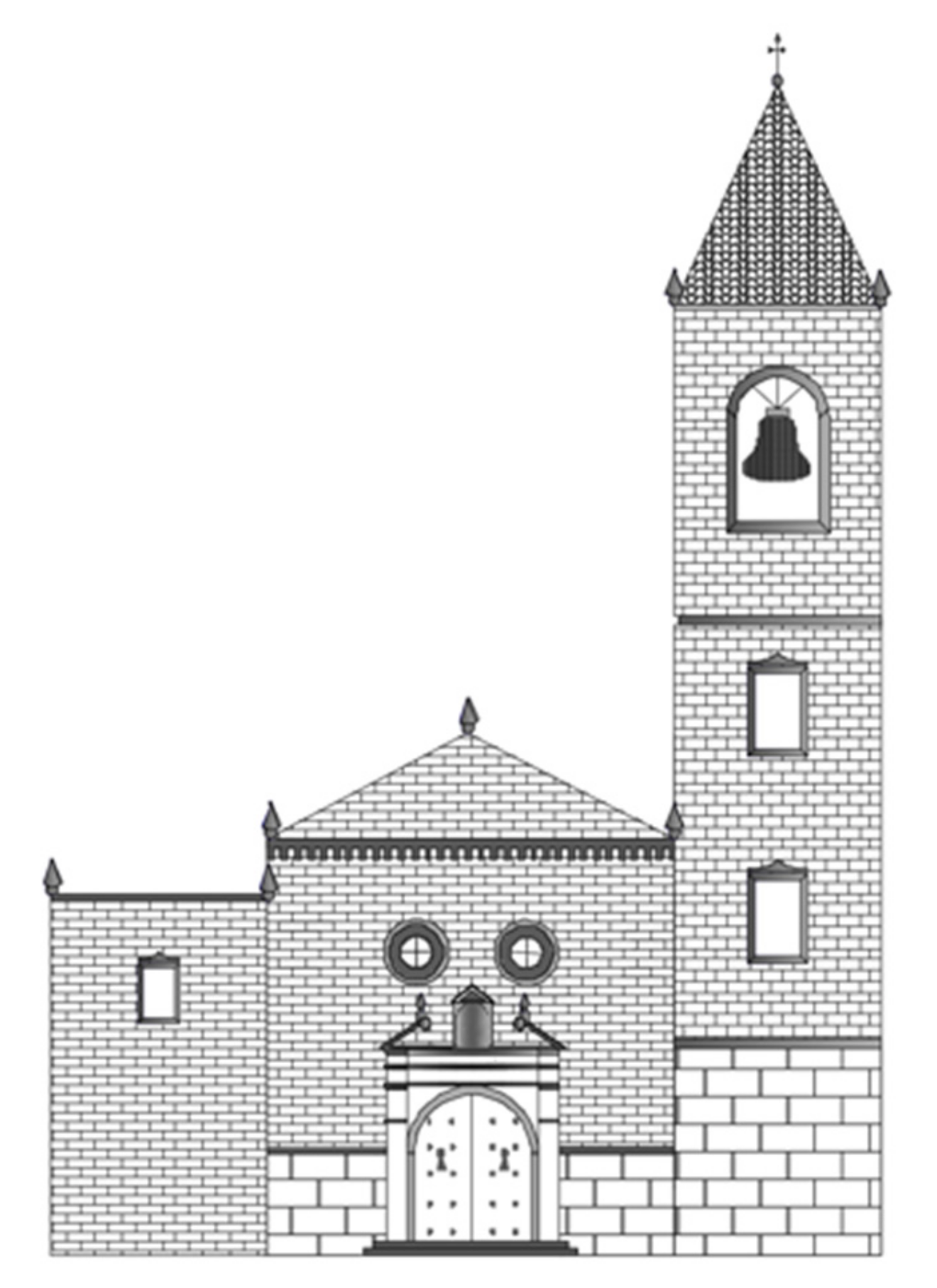
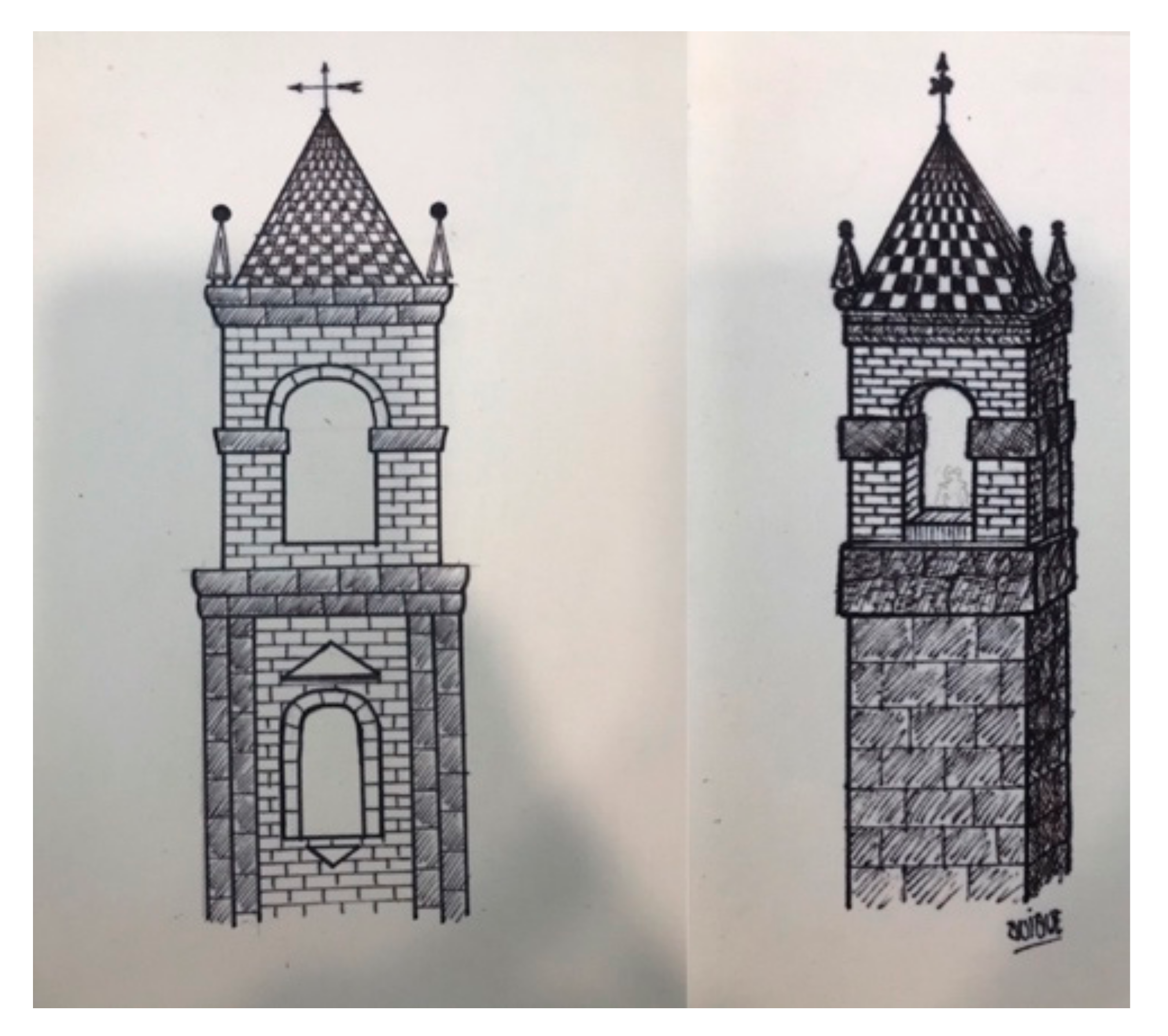





| INDICATOR | CALCULATION | UD | ACCEPTANCE INDEX |
|---|---|---|---|
| ECTM | l | ||
| ECIP | Electric power of the tool used (Kw) × Usage time (h) | Kwh | |
| ALEQ | % | 90% | |
| LURRM | % | 80% | |
| MRW | % | 80% | |
| MRcW | % | 80% | |
| EFSRP | % | 90% | |
| DPIS | km | 20 km | |
| LE | % | 80% |
© 2020 by the authors. Licensee MDPI, Basel, Switzerland. This article is an open access article distributed under the terms and conditions of the Creative Commons Attribution (CC BY) license (http://creativecommons.org/licenses/by/4.0/).
Share and Cite
Calvo-Serrano, M.A.; Castillejo-González, I.L.; Montes-Tubío, F.; Mercader-Moyano, P. The Church Tower of Santiago Apóstol in Montilla: An Eco-Sustainable Rehabilitation Proposal. Sustainability 2020, 12, 7104. https://doi.org/10.3390/su12177104
Calvo-Serrano MA, Castillejo-González IL, Montes-Tubío F, Mercader-Moyano P. The Church Tower of Santiago Apóstol in Montilla: An Eco-Sustainable Rehabilitation Proposal. Sustainability. 2020; 12(17):7104. https://doi.org/10.3390/su12177104
Chicago/Turabian StyleCalvo-Serrano, M. Araceli, Isabel L. Castillejo-González, Francisco Montes-Tubío, and Pilar Mercader-Moyano. 2020. "The Church Tower of Santiago Apóstol in Montilla: An Eco-Sustainable Rehabilitation Proposal" Sustainability 12, no. 17: 7104. https://doi.org/10.3390/su12177104
APA StyleCalvo-Serrano, M. A., Castillejo-González, I. L., Montes-Tubío, F., & Mercader-Moyano, P. (2020). The Church Tower of Santiago Apóstol in Montilla: An Eco-Sustainable Rehabilitation Proposal. Sustainability, 12(17), 7104. https://doi.org/10.3390/su12177104





